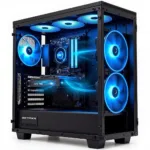Fan control is a crucial aspect of server management, especially for Dell servers known for their robust performance and reliability. This comprehensive guide will equip you with the knowledge to understand how fans operate, the importance of fan control, and how to effectively manage them to optimize your Dell server’s efficiency and longevity.
What is Fan Control?
In simple terms, fan control is the ability to monitor and adjust the speed of your server’s fans. Dell servers come equipped with intelligent fan management systems that automatically adjust fan speed based on internal temperature sensors. This ensures the server stays cool while minimizing noise and energy consumption.
Why is Fan Control Important?
Fan control plays a critical role in maintaining optimal server performance and extending its lifespan. Here’s why it matters:
- Temperature Regulation: Fans keep internal components cool, preventing overheating and potential damage. Proper fan control ensures optimal temperature for all hardware, including CPUs, RAM, and storage drives.
- Energy Efficiency: By adjusting fan speeds based on real-time temperature requirements, fan control minimizes unnecessary power consumption, leading to reduced energy bills and a lower environmental impact.
- Noise Reduction: Fan control can significantly reduce noise levels generated by the server. This is particularly important in data centers and other sensitive environments.
- Hardware Longevity: Properly controlled fans contribute to a longer lifespan for server components. Overheating is a major cause of premature failure, and fan control mitigates this risk.
How Fan Control Works in Dell Servers
Dell servers utilize a sophisticated fan management system that monitors internal temperatures and dynamically adjusts fan speeds. This system typically relies on:
- Temperature Sensors: Strategically placed temperature sensors within the server continuously monitor the heat levels of key components.
- Control Logic: The server’s BIOS or embedded controller uses the sensor data to determine optimal fan speeds.
- Fan Speed Adjustment: The control logic signals fans to increase or decrease their speed, ensuring efficient heat dissipation without exceeding noise or power consumption thresholds.
Fan Control Techniques in Dell Servers
Dell servers offer various methods for managing fan control, enabling users to tailor their fan speed configurations based on specific requirements:
- Dell OpenManage: This powerful software suite provides comprehensive control over server hardware, including fan management. Users can monitor fan speeds, set thresholds, and adjust settings to optimize server performance and noise levels.
- BIOS Settings: Dell server BIOS settings offer a range of options for customizing fan behavior, including fan speed profiles and alert configurations.
- Command-line Tools: Advanced users can leverage command-line utilities provided by Dell to fine-tune fan speed settings and monitor system health.
Understanding Fan Error Codes
When a fan error occurs in a Dell server, it is crucial to understand the error code displayed to diagnose the problem effectively. Some common fan error codes include:
- Fan Failure: Indicates a malfunctioning fan that needs replacement.
- Fan Speed Out of Range: This code points to an issue where the fan is not spinning at the correct speed.
- Fan Speed Not Available: A possible issue with the fan speed sensor or communication with the fan control system.
Best Practices for Fan Control
To ensure optimal fan control and server health, follow these best practices:
- Monitor Regularly: Keep a close eye on fan speeds and temperatures using Dell OpenManage or other monitoring tools.
- Clean Regularly: Dust accumulation can hinder fan performance and contribute to overheating. Regularly clean fans and air filters to maintain airflow.
- Avoid Overclocking: Overclocking can generate excessive heat, putting extra strain on fans. Use default settings or moderate overclocking with careful temperature monitoring.
- Proper Airflow: Ensure adequate airflow around the server. Avoid obstructing air vents and ensure sufficient space for proper ventilation.
- Regular Maintenance: Perform routine maintenance checks to identify potential fan issues early on, including inspecting for damage and lubricating bearings.
Fan Control and Server Performance Optimization
Fan control plays a significant role in server performance optimization by:
- Reducing CPU Throttling: Proper fan control ensures that the CPU operates within its optimal temperature range, minimizing throttling and maximizing performance.
- Improving Data Center Efficiency: By reducing fan speed and power consumption, fan control contributes to overall data center energy efficiency.
- Extending Hardware Lifespan: Effective fan management safeguards against premature component failure due to overheating, extending the lifespan of the server.
Fan Control: A Key Element of Server Management
“Fan control is not just about keeping the server cool. It’s about optimizing its performance, extending its lifespan, and ultimately enhancing its overall value,” says Sarah Johnson, a seasoned IT engineer with over 15 years of experience in server management.
By understanding the importance of fan control and implementing best practices, you can ensure your Dell servers operate at peak performance, maintain optimal efficiency, and deliver reliable service for years to come.

